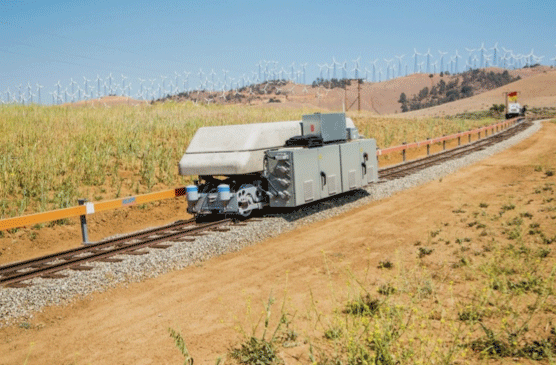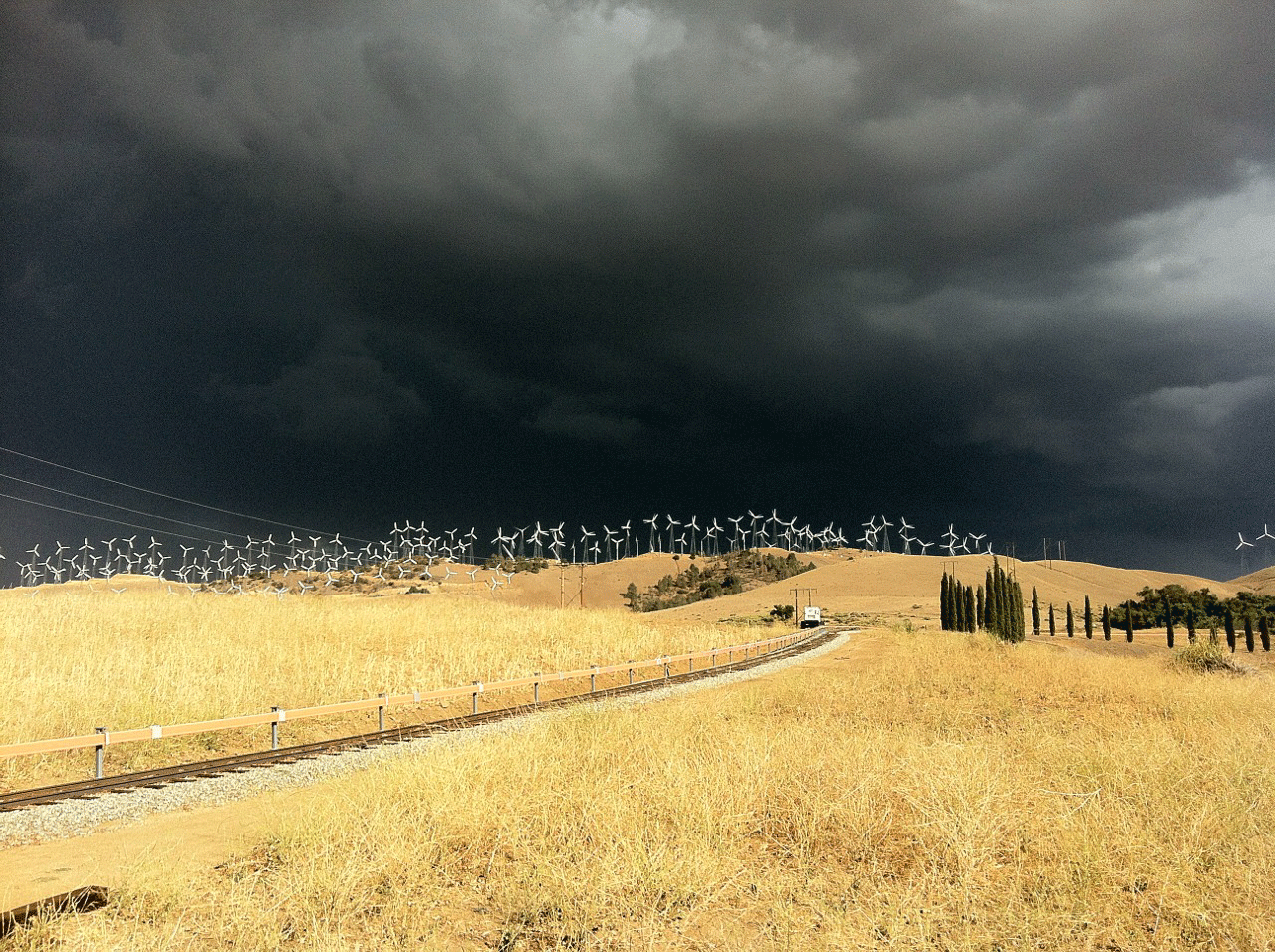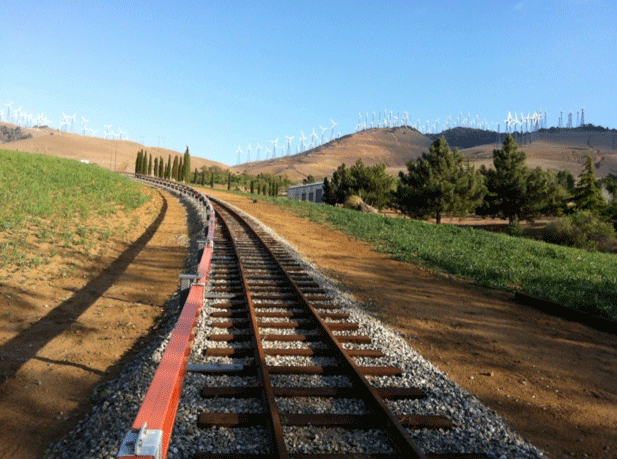A rail car the size of a go-kart creeps 850 feet up a steel track through the Tehachapi foothills near Death Valley. Its passenger is a four-ton concrete block, but the real delivery is electricity.
The train is a low-tech attempt to solve a hi-tech problem. California is now generating so much renewable electricity at certain times during the day that the state can’t use it all. The three biggest utilities now draw more than 20 percent of their energy from renewable sources. That number should climb higher as falling technology costs spur more investment in solar and wind power.
But the boom has drawbacks: A cloudy day can turn a flood of solar power into a drip. And a sunny day can generate more power than the grid can use.
Faced with the demand to ensure a stable supply of electricity, utilities are under pressure to develop cost-effective ways to store renewable power. The Public Utilities Commission has mandated that California’s three biggest electricity retailers find ways to store 1,300 megawatts of their total power production—about half the generating capacity of the old San Onofre Nuclear Generating Station—in the next five years.
Numerous companies are vying to break into the market, many of them relying on cutting-edge technology. One company is stacking batteries into massive hubs two stories tall. Another is compressing air in vast storage tanks, which can be released through turbines to generate electricity. A product called “Ice Bear” latches onto rooftop air conditioners to store electricity by creating and melting ice.

Jim Kelly is putting his money on trains. His company, Advanced Rail Energy Solutions, or ARES, bills his upcoming project—a $40 million plan to deliver 50 megawatts of storage in Nevada—as a simpler solution, delivering the same effect without all the flashy technology.
“We don’t need any new physics, we don’t need super conductivity or miracle batteries,” Kelly says. They just need gravity.
A pilot site in the hills some two dozen miles outside Bakersfield suggests how the operation will work. At Victory Springs Ranch in Tehachapi, a railway climbs 60 feet above its starting point, snaking through a hilly field dotted with wind turbines. Here, an ARES rail car climbs a gentle incline at 10mph. It carries concrete formed into a sleek trapezoid atop a steel carriage with four sets of wheels. The unit, stretching 16 feet long and nearly four feet tall, runs on a track set into the dusty Earth, spurred uphill by excess electricity coming off the grid.
The system would kick into gear any time renewable energy production overloads the grid. Grid operators would call ARES, which would use the excess power to drive the train. As soon as renewable production flags, an engineer can send the car downhill by striking a computer key. As the car rolls with gravity, motors inside a metal box latched to the concrete spin to generate electricity. Power goes back on the grid.
The ARES founders didn’t set out to make trains. William Peitzke, a veteran of the energy business, came to scientist John Robinson with ideas to build a hydro-electric pump near the Sea of Cortez. This system, introduced in the early 1900s and used around the world, uses excess power to pump water uphill, and then generates power when it is released back down.
But Robinson, a former National Oceanic and Atmospheric Administration scientist who was working at NASA when humans first stepped onto the moon, deemed this system too demanding on the West’s water supply.
Instead, Peitzke and Robinson turned to Matt Brown, a ship and plane engineer, for a solution that would not rely on scarce water resources. His answer: rail. He knew trains had long excelled at moving mass over distance and height.

The trio launched ARES in 2009. In 2013, ARES secured a patent and constructed its pilot project at Victory Springs Ranch.
The company plans to break ground on its first commercial project next year in Nevada, 60 miles west of Las Vegas on the California border. Here, the scale will dramatically increase: ARES plans to install a six-mile track climbing 2,000 feet. Seven “shuttle trains”—each equipped with two locomotives hauling seven cars—will ascend at 18mph. Each shuttle train will carry 1,300 tons, the weight of 650 automobiles. They will stretch nearly 500 feet long.
When gravity spurs the trains downhill, they will collectively generate 12.5 megawatt hours of energy. This is enough to power a city of 50,000 homes for 15 minutes.
That size is substantial compared with batteries that can hold only five or 10 megawatts. Still, it represents just a fraction of the capacity ARES envisions. The company’s original plan was to run 800 cars on multiple tracks, storing up to 1,000 megawatts, which could power more than half a million homes. But the financing proved too difficult for the fledgling business, says Francesca Cava, vice president for operations.
Just connecting storage to the transmission grid can cost $10 to $15 million, according to Cava. Securing a land permit can cost another million. And that’s before building and operation costs. The ARES Nevada project will suck up a total of $40 million as-is, but the bigger version would have required $1 billion.
“That’s a huge barrier to any Tom, Dick, or Harry coming along,” Cava says, adding that banks are wary of giving newbie storage companies the same funds they dole out for housing and railroad construction. ARES turned to investors instead, and has raised $25 million so far.

“This is not a market that you dilly-dally in,” Cava says. “They believed this would work and they would make money.”
For its next phase, ARES is gearing up to tackle more financial hurdles. Snagging utility contracts could help ARES secure loans. But setting a fair price is complicated. While utilities know how to charge for energy production, calculating the costs for storage is new.
ARES will need to compete against technologies that boast diverse merits. Hydro-electric pumps, moving at slow speeds, can shift large amounts of energy. Batteries and flywheels, on the other hand, offer flexibility by transferring energy within seconds—even if they can only hold small volumes.
ARES says it operates at 60 percent of the costs of traditional hydro pumps, and is less expensive than most batteries. For example, a battery under construction by Southern California Edison, billed as one of the biggest in North America, is slated to store 32 megawatts at a cost of $50 million. By ARES’s own measurements, its rail project will generate nearly twice as much for about the same amount.
To Mark Higgins of the California Energy Storage Alliance, the diversity of storage technology attests to the growing strength of the market. “It’s absolutely healthy, and really shows the competitive nature of the industry,” he says.
The competition is forcing a time crunch. ARES estimates that batteries won’t catch up with its own storage capacity for another two decades. But the company is still under pressure to be the first of its kind to penetrate the market, Cava says.
“If we are able to be the first grid-scale, non-polluting, not-water-using, profit-making energy storage system, obviously that’s a very important milestone,” she says.

This story is part of our week-long special report on energy issues in California produced in collaboration with the University of Southern California’s Annenberg School for Communication and Journalism. For more, visit the project’s landing page.





